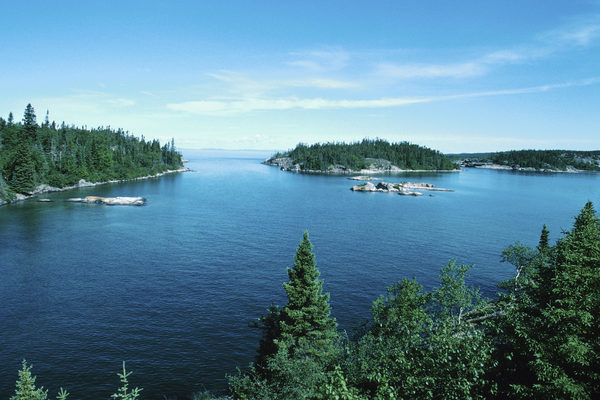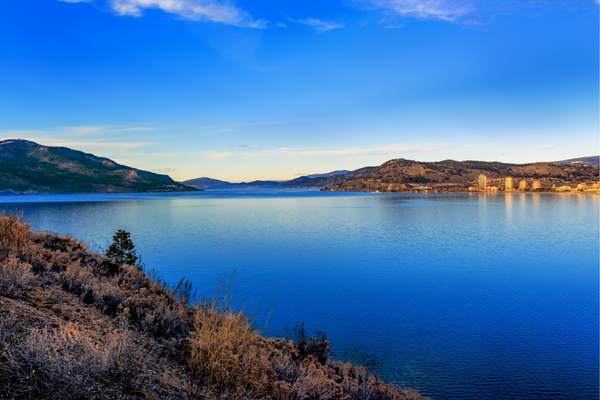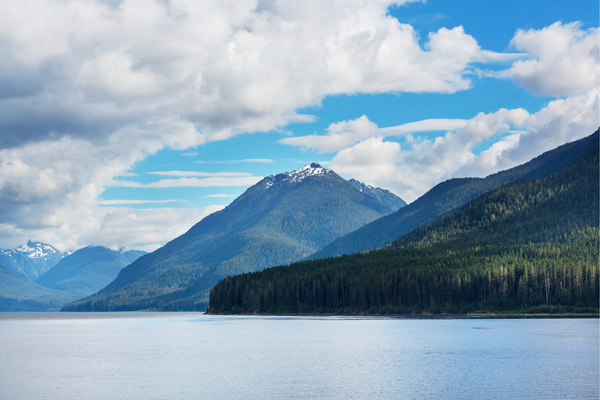lakes in canada – By Malsha – eLanka

Canada has thousands of lakes, many of which are considered among the most beautiful in the world. Here are some of the most notable lakes in Canada:
- Lake Superior
- Great Slave Lake
- Lake Huron
- Great Bear Lake
- Lake Erie
- Lake Winnipeg
- Reindeer Lake
- Lake Ontario
- Lake Athabasca
- Lake Nipigon
- Lake Manitoba
- Quesnel Lake
- Lake of the Woods
- Wollaston Lake
- Okanagan Lake
- Lake Simcoe
- Lesser Slave Lake
- Lake Temagami
- Lake Cowichan
- Lake Louise
These are just a few of the many lakes in Canada, and each one has its own unique features and attractions.
- Lake Superior
Lake Superior is the largest of the Great Lakes of North America and is shared by Canada and the United States. It is located in the northern part of North America, bordered by the provinces of Ontario to the north and west, and by the states of Minnesota, Wisconsin, and Michigan in the south.
Here are some facts about Lake Superior:
- It has a surface area of 31,700 square miles (82,100 square kilometers).
- It is the third-largest freshwater lake in the world by volume, with a maximum depth of 1,333 feet (406 meters).
- The lake is about 350 miles (560 kilometers) long and 160 miles (260 kilometers) wide.
- It is fed by over 200 rivers and streams, and its outflow is the St. Marys River.
- The lake has over 200 islands, with Isle Royale National Park being the most famous.
- The lake is known for its rugged coastline, pristine beaches, and crystal-clear water.
- The region surrounding the lake is home to a diverse range of wildlife, including wolves, moose, bears, and eagles.
- The lake has a significant commercial shipping industry, with iron ore being the primary cargo transported.
- The lake also attracts tourists for fishing, boating, camping, and hiking.
Overall, Lake Superior is a beautiful and important natural resource, both in terms of its ecological value and its economic significance to the region.
- Great Slave Lake
Great Slave Lake is the second-largest lake in Canada and the deepest lake in North America, with a maximum depth of 2,015 feet (614 meters). It is located in the Northwest Territories, in the northern part of Canada. Here are some facts about Great Slave Lake:
- It has a surface area of 10,502 square miles (27,200 square kilometers).
- The lake is about 300 miles (480 kilometers) long and 50 miles (80 kilometers) wide.
- It is fed by several rivers, including the Slave River, and its outflow is the Mackenzie River.
- The lake is frozen for most of the year, with ice cover lasting from late October to early June.
- The region surrounding the lake is home to several indigenous communities, including the Dene and the Métis.
- The lake is a popular destination for fishing, with several species of fish, including lake trout, northern pike, and Arctic grayling, present in its waters.
- The lake also attracts tourists for boating, camping, and hiking in the surrounding wilderness areas.
- The lake played an important role in the fur trade during the 18th and 19th centuries, with several trading posts established along its shores.
Overall, Great Slave Lake is a unique and important natural resource in Canada, both in terms of its ecological value and its cultural significance to the region’s indigenous communities.

- Lake Huron
Lake Huron is one of the five Great Lakes of North America and is shared by Canada and the United States. It is located in the eastern part of North America, bordered by the province of Ontario to the north and the states of Michigan to the west and south and Wisconsin to the southwest. Here are some facts about Lake Huron:
- It has a surface area of 23,000 square miles (59,600 square kilometers).
- It is the third-largest of the Great Lakes by surface area and the fifth-largest by volume.
- The lake is about 206 miles (332 kilometers) long and 183 miles (295 kilometers) wide.
- It is fed by several rivers, including the St. Marys River and the Saginaw River, and its outflow is the St. Clair River.
- The lake has over 30,000 islands, with Manitoulin Island being the largest.
- The region surrounding the lake is home to several indigenous communities, including the Anishinaabe and the Huron-Wendat.
- The lake is a popular destination for boating, fishing, camping, and hiking, with several parks and beaches along its shores.
- The lake also plays an important role in shipping, with several ports and harbors serving the Great Lakes region.
Overall, Lake Huron is a beautiful and important natural resource, both in terms of its ecological value and its economic significance to the region. It is also a cultural hub for the indigenous communities that have lived around the lake for centuries.
- Great Bear Lake
Great Bear Lake is the largest lake entirely within Canada and the fourth-largest lake in North America, after the Great Lakes. It is located in the Northwest Territories, in the northern part of Canada. Here are some facts about Great Bear Lake:
- It has a surface area of 12,028 square miles (31,328 square kilometers).
- The lake is about 232 miles (373 kilometers) long and 111 miles (178 kilometers) wide.
- It is fed by several rivers, including the Dease, the Camsell, and the Johnny Hoe, and its outflow is the Great Bear River, which empties into the Mackenzie River.
- The lake is frozen for most of the year, with ice cover lasting from late November to mid-June.
- The region surrounding the lake is home to several indigenous communities, including the Sahtu Dene and the Métis.
- The lake is a popular destination for fishing, with several species of fish, including lake trout, Arctic grayling, and whitefish, present in its waters.
- The lake also attracts tourists for boating, camping, and hiking in the surrounding wilderness areas.
- The lake has played an important role in the traditional culture and subsistence activities of the indigenous communities in the region.
Overall, Great Bear Lake is a unique and important natural resource in Canada, both in terms of its ecological value and its cultural significance to the region’s indigenous communities.
- Lake Erie
Lake Erie is one of the five Great Lakes of North America and is located on the border between the United States and Canada. It is the fourth-largest of the Great Lakes by surface area and the shallowest, with an average depth of 62 feet (19 meters). Here are some facts about Lake Erie:
- It has a surface area of 9,910 square miles (25,700 square kilometers).
- The lake is about 241 miles (388 kilometers) long and 57 miles (92 kilometers) wide.
- It is bordered by the states of Ohio, Pennsylvania, and New York in the United States, and the province of Ontario in Canada.
- The lake is fed by several rivers, including the Detroit River, the Maumee River, and the Niagara River, and its outflow is the Niagara River, which empties into Lake Ontario.
- The lake has several islands, including Pelee Island, the largest island in the lake.
- The region surrounding the lake is home to several cities, including Cleveland, Erie, and Buffalo, which are important industrial and commercial centers.
- The lake is a popular destination for boating, fishing, swimming, and other recreational activities, with several parks and beaches along its shores.
- The lake has faced environmental challenges, including pollution and harmful algal blooms, which have impacted the health of the lake and its ecosystem.
Overall, Lake Erie is an important natural resource and a popular destination for recreation and tourism. It also plays an important role in the economy of the region, supporting industries such as shipping, fishing, and tourism.
- Lake Ontario
Lake Ontario is one of the five Great Lakes of North America, located on the border between the United States and Canada. It is the smallest of the Great Lakes by surface area and the second-smallest by volume. Here are some facts about Lake Ontario:
- It has a surface area of 7,320 square miles (18,960 square kilometers).
- The lake is about 193 miles (311 kilometers) long and 53 miles (85 kilometers) wide.
- It is bordered by the state of New York in the United States, and the province of Ontario in Canada.
- The lake is fed by several rivers, including the Niagara River, the Genesee River, and the Oswego River, and its outflow is the St. Lawrence River, which empties into the Gulf of St. Lawrence.
- The lake has several islands, including Wolfe Island, the largest island in the lake.
- The region surrounding the lake is home to several cities, including Toronto, Rochester, and Hamilton, which are important industrial and commercial centers.
- The lake is a popular destination for boating, fishing, swimming, and other recreational activities, with several parks and beaches along its shores.
- The lake has faced environmental challenges, including pollution and invasive species, which have impacted the health of the lake and its ecosystem.
Overall, Lake Ontario is an important natural resource and a popular destination for recreation and tourism. It also plays an important role in the economy of the region, supporting industries such as shipping, fishing, and tourism.
- Wollaston Lake
Wollaston Lake is a large lake located in northeastern Saskatchewan, Canada. Here are some facts about Wollaston Lake:
- It has a surface area of 1,048 square miles (2,715 square kilometers), making it the ninth largest lake in Saskatchewan.
- The lake is about 97 miles (156 kilometers) long and 31 miles (50 kilometers) wide at its widest point.
- It is located in a remote area of the province and is only accessible by air or by a seasonal gravel road.
- The lake is known for its clear waters and its abundance of fish, including lake trout, northern pike, and walleye.
- The region surrounding the lake is home to several First Nations communities, including the Hatchet Lake Denesuline First Nation and the Wollaston Lake community.
- The lake and surrounding area are important for the traditional subsistence activities of the indigenous communities in the region, including hunting, fishing, and trapping.
- The lake and its surrounding wilderness areas are a popular destination for outdoor recreation, including fishing, hunting, and camping.
Overall, Wollaston Lake is an important natural resource and a significant cultural and economic hub for the surrounding First Nations communities. It also provides an important destination for outdoor recreation in the remote and beautiful wilderness of northern Saskatchewan.

- Okanagan Lake
Okanagan Lake is a large freshwater lake located in the Okanagan Valley of British Columbia, Canada. Here are some facts about Okanagan Lake:
- It has a surface area of 84 square miles (215 square kilometers) and is about 84 miles (135 kilometers) long.
- The lake is known for its crystal-clear waters, sandy beaches, and stunning scenery, and it is a popular destination for boating, swimming, and other recreational activities.
- The lake is fed by several rivers, including the Okanagan River, which flows into the lake at its north end, and its outflow is the Okanagan River, which flows south and empties into the Columbia River.
- The lake has several islands, including Rattlesnake Island, which is a popular destination for camping and picnicking.
- The region surrounding the lake is home to several cities and towns, including Kelowna, Penticton, and Vernon, which are important centers for tourism, agriculture, and technology.
- The area is known for its vineyards and wineries, and the lake provides an important source of irrigation for agriculture in the region.
- The lake and surrounding area are also home to several First Nations communities, including the Okanagan Nation, which has inhabited the region for thousands of years.
- The lake and surrounding wilderness areas are a popular destination for outdoor recreation, including hiking, mountain biking, and skiing.
Overall, Okanagan Lake is an important natural resource and a significant cultural and economic hub for the surrounding communities. It provides a stunning backdrop for outdoor recreation and is a popular destination for tourists and locals alike.
- Lake Temagami
Lake Temagami is a large freshwater lake located in northeastern Ontario, Canada. Here are some facts about Lake Temagami:
- It has a surface area of 304 square kilometers (117 square miles) and is about 35 kilometers (22 miles) long and 20 kilometers (12 miles) wide at its widest point.
- The lake is known for its clear waters, numerous islands, and rugged wilderness surroundings, and it is a popular destination for boating, fishing, and camping.
- The lake is fed by several rivers and streams, including the Temagami River, which flows into the lake at its southeast end, and its outflow is the Sturgeon River, which flows northeast and empties into Lake Nipissing.
- The lake has hundreds of islands, many of which are undeveloped and provide opportunities for wilderness camping and exploration.
- The region surrounding the lake is home to several small towns and communities, including the town of Temagami, which is a popular hub for tourism and outdoor recreation.
- The lake and surrounding area are also home to several First Nations communities, including the Temagami First Nation, which has inhabited the region for thousands of years.
- The lake and surrounding wilderness areas are a popular destination for outdoor recreation, including canoeing, kayaking, hiking, and fishing.
- The lake is also home to several species of fish, including lake trout, northern pike, and walleye, which provide important recreational and commercial fisheries.
Overall, Lake Temagami is an important natural resource and a significant cultural and economic hub for the surrounding communities. It provides a stunning wilderness setting for outdoor recreation and is a popular destination for tourists and locals alike.







